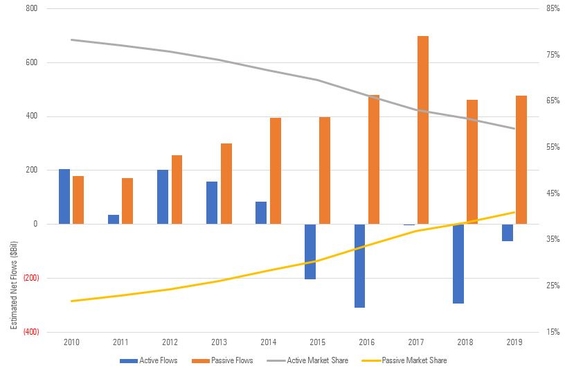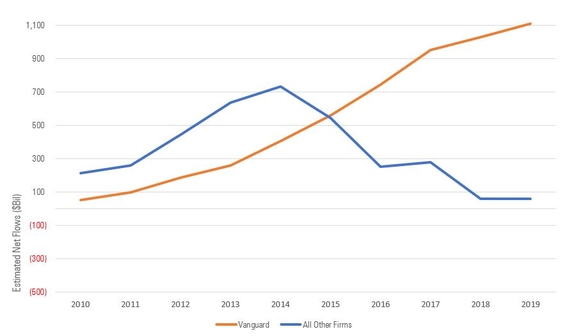The past decade saw huge shifts in the fund industry. It all began in the wake of the 2007-2009 credit crisis. The decade saw the Federal Reserve’s most-stimulative monetary policy in U.S. history. There was the longest ongoing equity bull market in history, in which the S&P 500 Index gained an annualized 13.6% over the past 10 years. Finally, the decade saw a massive demographic shift as baby boomers began to retire en masse.
All these forces contributed to major shifts in investor preferences that manifested in fund flows. Key trends of the decade included:
- An overwhelming move from actively managed funds to much cheaper passive vehicles
- The movement toward target-date funds
- A shift toward bond funds and away from equity funds, despite the long-running bull market, which demonstrated how much investor behavior has changed and how old saws about retail investors chasing returns no longer apply
- The surge in long-term fund assets (excluding money market funds), to $20.8 trillion from $9.1 trillion
Fund flows surge into target-date funds
A key trend of the past decade was the rise of target-date funds and other types of managed portfolios, which became popular retirement-savings vehicles as big fund companies rolled out their own lineups and they were added to company 401(k) plans. As shown on the chart below, assets in target-date funds nearly tripled from just under $700 billion in January 2010 to nearly $2 trillion at the end of the decade, although inflows trailed off in recent years.

Source: Morningstar Direct. Data through 12/31/19.
Most of these assets are invested in underlying funds, which then had a substantial impact on the direction of fund flows. Flows into underlying funds were driven both by flows into the target-date funds themselves, which trickle into the underlying funds, as well as by target-date rebalancing. The latter was often triggered by events in the capital markets: For example, a big move in equity indexes would often lead to rebalancing by target-date funds. This occurred during 2018’s correction, when inflows into U.S. equity funds actually increased.
The ascent of core strategies
The increasing popularity of target-date funds largely contributed to the popularity of core-oriented strategies over the past decade, as did the growing—and related—interest in passive strategies. Four Morningstar Categories—large blend, intermediate core bond, intermediate core-plus bond, and foreign large blend—tend to be portfolio building blocks and the foundation of many target-date funds. Those categories also collected more in inflows over the past decade than did all other categories combined.
Core strategies’ rise throughout the 2010s is shown on the chart below, which shows cumulative inflows.
Which categories saw big outflows?
The shift in investor preferences over the past decade has resulted in numerous casualties. Three of the biggest were allocation, alternative, and sector equity funds, which the chart below shows were hit particularly hard over the past five years.

Source: Morningstar Direct. Data through 12/31/19.
Here’s a closer look at each category’s outflows:
- Allocation funds, previously called “balanced” funds, seem to be the biggest loser from the rise of target-date funds. They had their fifth consecutive year of outflows ($34.6 billion) in 2019.
- Alternative funds were introduced to great fanfare in the first few years following the credit crisis but haven’t shown much staying power overall. They had $8.6 billion in 2019 outflows, which was the second consecutive year of outflows and the third in the past four years.
- Sector equity funds had $31.4 billion of outflows in 2019, the group’s worst year in the past decade.
A look at active-passive fund flows and market share
It’s no secret that passive funds dominated inflows over the past decade. Still, the raw data is stunning. As the chart below shows, passive funds had inflows of $3.8 trillion, while actively managed funds had outflows of $185 billion. Meanwhile, overall active market share—as measured by total assets—fell from 78.3% to 59.0%. If present trends continue, it’s simply a matter of time before passive assets catch up to their active counterparts.

Source: Morningstar Direct. Data through 12/31/19.
Fund flows for the top five firms
The fund industry has increasingly become an oligopoly, with only a few firms capturing nearly all of the net inflows. More specifically, the past decade emphasized how Vanguard dominated the rest of the industry.
As shown on the chart below, Vanguard collected about $1.1 trillion during the decade, while the rest of the industry combined took in less than $100 billion net. Of course, firms such as iShares also fared well, but no individual firm came close to matching Vanguard during the decade. Whether Vanguard can repeat this performance over the next 10 years, however, is an open question.

Source: Morningstar Direct. Data through 12/31/19.


.JPG?auto=webp&disable=upscale&width=565)